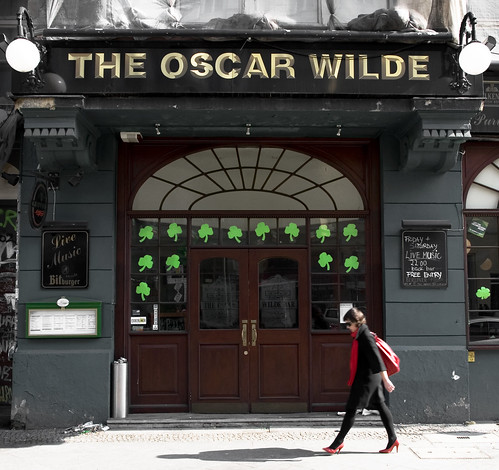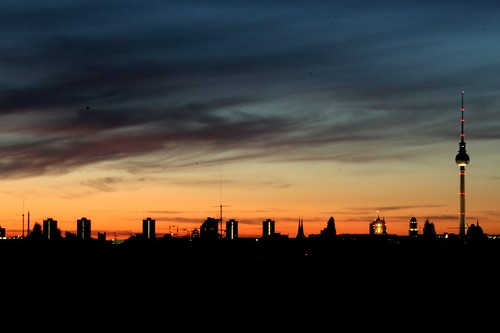View Larger Share
Wednesday, March 31, 2010
Monday, March 29, 2010
YUPPIES CROSSING
View Larger
The artist Citénoir places a sign "Yuppies Crossing" in a gentrified zone of Kreuzberg in the Bergmanstrasse.
Artist Website: www.CitéNoir.net/ Share
Tuesday, March 23, 2010
Wednesday, March 17, 2010
The Last Tango in Berlin
View Larger
A couple dances Tango near the Brandeburg Gate to earn money from tourists. During the summer, it is common to have performances near Berlin´s "postcard". Share
Labels:
berlin,
brandenburg gate,
dancer,
street,
tango
Saturday, March 13, 2010
das ehemalige Restaurant am Flughafen Tempelhof
View Larger
Berlin Tempelhof Airport (German: Flughafen Berlin-Tempelhof) was an airport in Berlin, Germany, situated in the south-central borough of Tempelhof-Schöneberg. The airport ceased operating 2008 in order to make Schönefeld the sole commercial airport for Berlin.
Designated by the Ministry of Transport on 8 October 1923, Tempelhof became the world's first airport with an underground railway station in 1927, now called Platz der Luftbrücke after the Berlin Airlift. While occasionally cited as the world's oldest still-operating commercial airport, the title was disputed by several other airports, and has in any case been moot since its closure.
Tempelhof was one of Europe's three iconic pre-World-War-II airports — the others being London's now-defunct Croydon Airport and the old Paris - Le Bourget Airport. One of the airport's most distinguishing features is its large, canopy-style roof that was able to accommodate most contemporary airliners during its heyday in the 1950s, 1960s and early 1970s, thereby protecting passengers from the elements. Tempelhof Airport's main building was once among the top 20 largest buildings on earth. Tempelhof formerly had the world's smallest duty-free shop.
Tempelhof Airport closed all operations on 30 October 2008, despite the efforts of some protesters to prevent the closure.
Source Share
Friday, March 12, 2010
Wednesday, March 10, 2010
Monday, March 8, 2010
Saturday, March 6, 2010
KINO
View Larger
The Kino International is a film theater in Berlin. It is located on Karl-Marx-Allee in former East Berlin and hosted premieres until the fall of the Berlin Wall in 1989.
Das Kino International diente bis 1989 als Premierenkino der DDR. Zahlreiche DEFA-Filme hatten hier ihre Premiere. Speziell für die Partei- und Staatsführung wurde die achte Reihe, in der man eine optimale Sicht hatte, mit einer besonderen Beinfreiheit versehen. Vor und nach den Premieren hielten sich die Besucher der Staatsführung im „Repräsentationsraum“ (heute „Honecker-Lounge“) auf. Im Keller wurde für die Staatsführung ein wenige Personen fassender Bunker und im Gebäudeinneren ein Aufzug nachträglich eingebaut. Seine letzte Premiere in der DDR fand am 9. November 1989, dem Tag des Mauerfalls, mit Heiner Carows „Coming Out“ statt.
Heute wird das International von zahlreichen Filmemachern aufgrund seines Ambientes wieder als Premierenkino genutzt und ist Spielstätte im Rahmen der Berlinale. Es ist beliebt bei den Berliner Kinogängern als Kino mit Tradition und besonderer Atmosphäre. Die sehr großen Filmplakate des Films der Woche an der Außenseite des Internationals werden noch per Hand von Filmplakate-Malern gezeichnet und sind ein echter Blickfang.
quelle: de.wikipedia.org/wiki/Kino_International Share
Wednesday, March 3, 2010
Turkish in Kreuzberg
View Larger
Kreuzberg is a very popular Berlin neighborhood for raising kids, the Turkish population, and the "hipsters" or foreigners who come to Berlin to live an work. There are also, of course, many young german families who feel the district is very "kid-friendly" and close to schools.Share
Everyone lives close to each other but when will people be integrated?
Berlin: We So Cool Like New York in the 80s
View Larger
Street art is any art developed in public spaces -- that is, "in the streets" -- though the term usually refers to unsanctioned art, as opposed to government sponsored initiatives. The term can include traditional graffiti artwork, stencil graffiti, sticker art, wheatpasting and street poster art, video projection, art intervention, guerrilla art, flash mobbing and street installations. Typically, the term Street Art or the more specific Post-Graffiti is used to distinguish contemporary public-space artwork from territorial graffiti, vandalism, and corporate art.
source:
en.wikipedia.org/wiki/Street_art
View more photos of Street Art in Berlin here.
Yo!
Tuesday, March 2, 2010
KOSMOS
View Larger
Share
The "Kosmos" (Cosmos) was a large cinema located on the street Karl-Marx-Allee in Berlin, Germany. During the GDR (DDR) East Germany time, it was the largest cinema in the country. It was later converted to an event center but used to seat over 3400 people.
Das Kosmos war ein Großraumkino an der Berliner Karl-Marx-Allee. Es war das größte Kino der DDR und wurde bis 1989 als Premierenkino genutzt. Nach der Wende übernahm es die UFA, die das Kino 1996 in ein Multiplex-Kino für 3400 Zuschauer umbauen ließ. 2005 wurde der Kinobetrieb im Kosmos durch die UFA eingestellt. Seit 2006 wird das Haus als Veranstaltungszentrum genutzt.
source: de.wikipedia.org/wiki/Kosmos_(Berlin)
Labels:
architecture,
berlin,
cinema,
friedrichshain,
kino,
KOSMOS,
typo
Subscribe to:
Posts (Atom)



